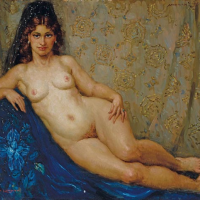47. NORMAN LINDSAY

Norman Lindsays prolific oeuvre was dominated by the female form, in all its voluptuous glory. As the artist explained, I have taken the feminine image as a dominant factor in my concept of life, both because I love the beauty of women, and because they are the continuity principle which drives life eternally on into the future.1 Lindsays nudes are characterised by their vivaciousness they invariably dominate the pictorial space, and appear emboldened by their nakedness. Lindsay openly rejected what he saw as the academic nude image of femininity as an innocuous stuffed dummy; instead, he sought to imbue his nudes with a palpable vitality and desirability.2
Lindsay always preferred to paint from life and is estimated to have employed 130 different models throughout the 1930s and 40s, using a notebook to record their names, addresses and salient attributes.3 Lindsay showed little interest in the society portrait, preferring instead to draw his models from the shopgirl, the servant-girl class.4 As the artist maintained, I would have no use for a highly intellectual, cultured lady as a model. It would put me out, having to pay the polite deference her class and culture would expect.5 Perhaps as a consequence, Lindsays portraits are often more revealing of the artist than their subject. Rather than aiming to slavishly replicate their features on canvas, Lindsay would approach his model as a live dummy from which to extract forms and colour; a unit in a composition.6 The final work would represent an outlandish projection of the artists own fantasies, drawn from classical mythology, history or literature. Only in the hands of Norman Lindsay could a casual hoyden plucked from the grimy streets of inner Sydney be transformed into an Olympian goddess.7
In Mantilla and Pearls, our subject poses magisterially on a dark chaise longue, her impassive gaze meeting the viewer directly. The womans shapely figure forms a serpentine curve, in a latter-day example of what William Hogarth (1697-1764) described as the line of beauty that which leads the eye in a pleasing manner along the continuity of its variety.8 In the absence of a fantastical setting, Lindsay has paid careful attention to the textured fabric draped behind the sitter, its delicate embroidery shimmering in the light of the studio. The sitter is adorned with a black lace mantilla, typically worn by the women of Andalusia in southern Spain. This distinctive headwear appears in many of Lindsays major oil paintings of the period, and no doubt appealed to his appetite for the grand and exotic.
Lindsay was a relative latecomer to the art of oil painting, having first honed his considerable talents as a watercolourist, draughtsman and printmaker. In 1934 Lindsay took up a studio at 12 Bridge Street, Sydney, and began to work expansively in oils for the first time.9 Lin Bloomfield has observed that oils allowed Lindsay to more faithfully capture flesh tones this being an essential objective for any painter of nudes.10 As shown by Mantilla and Pearls, Lindsays best oil portraits demonstrate a lusciousness and vitality that would be unattainable in any other medium.
Footnotes
1. Letter from Norman Lindsay to John Hetherington, February 1968, quoted in Bloomfield, L., Norman Lindsay Oil Paintings 1889-1969, Odana Editions, New South Wales, 2006, p.10
2. Ibid., p.10
3. Bloomfield, L., Norman Lindsay Oil Paintings 1889-1969, p.3
4. Letter from Norman Lindsay to Mary Lindsay, c1955, quoted in Bloomfield, L., Norman Lindsay Oil Paintings 1889-1969, p.3
5. Ibid., p.4
6. Ibid., p.4
7. Ibid., pp.3-4
8. Hogarth, W., The Analysis of Beauty, John Reeves, London, 1753, accessed online:
https://archiv.ub.uni-heidelberg.de/artdok/1217/1/Davis_Fontes52.pdf
9. Bloomfield, L., Norman Lindsay Oil Paintings 1889-1969, p.1
10. Ibid., p.1
Catherine Baxendale, B Phil (Hons), MA (Art Curatorship)